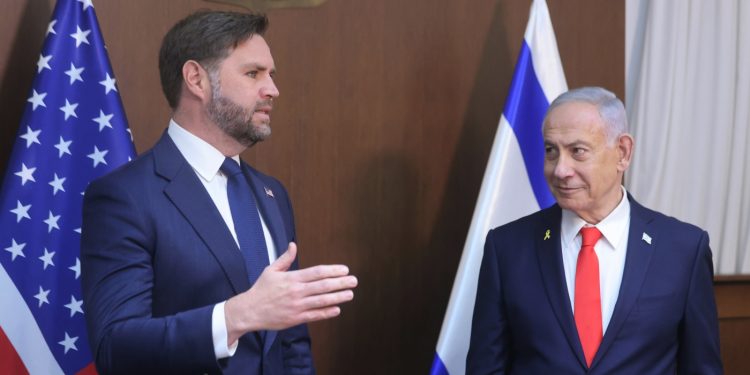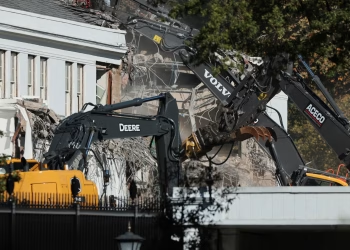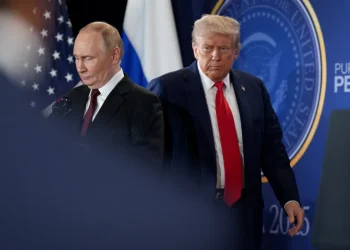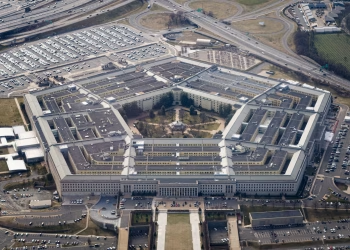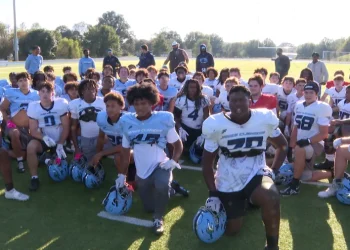
Vice President Vance meets with Israeli Prime Minister Benjamin Netanyahu in Jerusalem on Wednesday. Vance is among several high-level U.S. officials in Israel who support the ceasefire between Israel and Hamas.
Marc Israel Sellem/Pool Jerusalem Post via AP
hide caption
toggle caption
Marc Israel Sellem/Pool Jerusalem Post via AP
TEL AVIV, Israel — Vice President Vance said Wednesday that the ceasefire between Israel and Hamas stands, but he acknowledged the challenges of trying to completely end the war.
“We have a very difficult task ahead of us, which is to disarm Hamas but to rebuild Gaza,” Vance said after meeting Israeli Prime Minister Benjamin Netanyahu in Jerusalem.
Vance is part of a high-level U.S. team that is in Israel this week with the mission of keeping the truce on track and trying to extend it into a more difficult second phase.
Netanyahu is universally known in Israel as “Bibi.” Israeli media call this American contingent the “Bibisitters.”
Besides Vance, it includes Middle East envoy Steve Witkoff, President Trump’s son-in-law Jared Kushner and Admiral Brad Cooper, head of U.S. Central Command. Secretary of State Marco Rubio is also expected this week.
For his part, Netanyahu described the meeting with Vance as an “opportunity to make decisions jointly in a close-knit and trusted partnership.”
While the Americans are conducting extensive negotiations with the Israelis, American officials are not expected to meet with Hamas.
The United States classifies Hamas as a terrorist group, which prohibits any contact.
With a rare exception, Witkoff and Kushner said they met with Hamas leaders in Egypt to hammer out the final details of the ceasefire, which took effect October 10.
The truce holds, with many steps to take
The ceasefire in Gaza has largely held good, despite an upsurge in fighting last Sunday which left two Israeli soldiers and more than 40 Palestinians dead.

However, the so-called phase 2 of the truce deals with more difficult issues.
Gaza has no government, and it is unclear when it will have one. Hamas’s leadership was decimated during the war and the ceasefire agreement stipulates that the group will not participate in a future government.

The deal calls for 15 nonpartisan technocrats to take over on an interim basis, but there is no timetable.
Asked about the lack of government in Gaza, Vance said other needs should be met first, including food, medicine and security.
“If we get to the point where we’re discussing exactly what the long-term government structure is in Gaza, we should congratulate ourselves because it’s a very good problem to have. But I won’t anticipate that problem until we actually have it,” Vance said.
Vance made the remarks Tuesday in southern Israel, just 10 miles from the border with Gaza. He visited a civil-military coordination center built in recent days by 200 American soldiers.
This center will include officials from the United States and other countries, as well as humanitarian and other groups working in Gaza. The goal is to make sure everyone is operating from the same playbook.
The ceasefire plan also calls for Hamas to “decommission” its weapons, although the group has not publicly said it will do so. Vance stressed that this should happen, but declined to say exactly how it would work.
Additionally, Israeli troops – who still control half of Gaza – are expected to withdraw as the territory stabilizes.
Foreign troops are meant to replace the Israelis in Gaza as the international stabilization force. However, it is unclear which countries will provide the troops, when they might arrive or what exactly their mandate would be.
Israel is already making clear that it will have the final say on which troops are allowed to participate in this force.
Trump takes leading role, but no troops on the ground
Meanwhile, Trump has long said he would keep the United States out of “forever wars.”
But he also considers himself a master negotiator capable of ending wars. He is widely credited with establishing the truce in Gaza after two years of intense fighting.
His administration also emphasizes that the 200 American troops in Israel will work at the coordination center in Israel and will not go to Gaza.
Yet American presidents since Harry Truman have sought to resolve the Israeli-Palestinian conflict. And so far, none have succeeded in establishing real peace.


